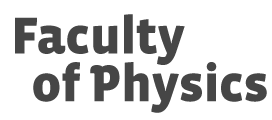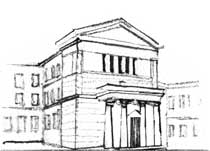Soft Matter and Complex Systems Seminar
2006/2007 | 2007/2008 | 2008/2009 | 2009/2010 | 2010/2011 | 2011/2012 | 2012/2013 | 2013/2014 | 2014/2015 | 2015/2016 | 2016/2017 | 2017/2018 | 2018/2019 | 2019/2020 | 2020/2021 | 2021/2022 | 2022/2023 | 2023/2024 | 2024/2025
2019-06-07 (Friday)
Prof. Antoine Sellier (LadHyX, Ecole Polytechnique, Palaiseau. France.)
Seminar is a part of the ITHACA project financed by the Polish National
Agency for Academic Exchange, and an event of the French-Polish Scientific Year 2019
Creeping flow about solid particles taking a slip boundary condition [UWAGA! Seminarium odbędzie się w IPPT PAN]
Statistical Physics Seminar
organized jointly by:
Faculty of Physics, UW & Division of Complex Fluids, IPPT PAN
____________________________________________________
Friday, June 7, 9:30, IPPT PAN, Pawinskiego 5B, Aula, 2nd floor
We show how a boundary approach is able to efficiently and accurately deal with the Stokes flow around a collection of solid particles on which the usual no-slip boundary condition is not relevant and is replaced either with a Smoluchowski (electrophoresis case) or a Navier slip boundary condition.
organized jointly by:
Faculty of Physics, UW & Division of Complex Fluids, IPPT PAN
____________________________________________________
Friday, June 7, 9:30, IPPT PAN, Pawinskiego 5B, Aula, 2nd floor
We show how a boundary approach is able to efficiently and accurately deal with the Stokes flow around a collection of solid particles on which the usual no-slip boundary condition is not relevant and is replaced either with a Smoluchowski (electrophoresis case) or a Navier slip boundary condition.
Seminar is a part of the ITHACA project financed by the Polish National
Agency for Academic Exchange, and an event of the French-Polish Scientific Year 2019
2019-05-31 (Friday)
Gustavo Abade (IGF UW)
Turbulent coagulation of cloud droplets
The mechanism responsible for rain in warm (i.e., ice-free) clouds is collision-coalescence among cloud droplets. Field observations show that rain showers can develop very quickly, on time scales much shorter than typical collision times predicted by theories that neglect air flow turbulence. Several effects of turbulence may reduce the time for warm rain initiation. This talk focuses on the effect of local clustering of inertial droplets that interact hydrodynamically. Quantitative description of turbulent collision of droplets represents a major unresolved problem in cloud physics.
2019-05-24 (Friday)
C.I. Trombley (IPPT PAN)
Stable Configurations Of Charged Particles Under Gravity In A Viscous Fluid
Earnshaw’s theorem is a fundamental theorem in electrostatics which states that no stationary electrostatic configuration in a vacuum is stable to perturbations. It is also well known that stationary arrangements of electrically neutral particles settling in a viscous fluid are also not stable. However, examining a theoretical model, two charged particles settling in a viscous fluid are shown to have configurations which are asymptotically stable to perturbations. This result was published in [1]. Stable stationary states exist for a wide range of charges, radii and densities. Necessary and sufficient conditions for the existence of such stable states are given and analyzed.
[1] Trombley CI, Ekiel-Jeżewska ML. Physical Review Letters. 2018 Dec 21; 121(25):254502.
[1] Trombley CI, Ekiel-Jeżewska ML. Physical Review Letters. 2018 Dec 21; 121(25):254502.
2019-05-17 (Friday)
Tomasz Bobiński (MEiL PW)
2) We consider the propagation of water waves in a waveguide with a surface-piercing circular cylinder. A plane wave interacting with the cylinder leads to a Fano resonance resulting in strong scattering with a large reflection coefficient. Using a smoothly varying bathymetry whose shape is optimized, we show both numerically and experimentally that broadband and robust backscattering reduction can be obtained below the first cutoff frequency.
1. Droplet interaction with air boundary layer
2. Metamaterials for water waves
1) Air boundary layer on rotating disk may support controlled droplet levitation resulting in their high mobility. We show it is possible to levitate a droplet in both laminar and turbulent regimes, provided one properly sets initial condition, i.e. initial distance between moving surface that generates boundary layer and the droplet. We explore the influence of cross-flow instability and associated spiral vortices on the levitation phenomenon. We characterize the role of disk velocity on the droplet shape and levitation distance from the moving surface.
2) We consider the propagation of water waves in a waveguide with a surface-piercing circular cylinder. A plane wave interacting with the cylinder leads to a Fano resonance resulting in strong scattering with a large reflection coefficient. Using a smoothly varying bathymetry whose shape is optimized, we show both numerically and experimentally that broadband and robust backscattering reduction can be obtained below the first cutoff frequency.
2019-04-26 (Friday)
Seminaria studenckie
Na najbliższym seminarium odbędzie się seria krótkich (10 min.) prezentacji studenckich:
Bartosz Greń - Struktura i statystyka nietrywialnych lass w polimerach i białkach
Mateusz Czaja - Rozpad pionu
Bartosz Greń - Struktura i statystyka nietrywialnych lass w polimerach i białkach
Mateusz Czaja - Rozpad pionu
2019-04-12 (Friday)
Seminaria studenckie
Na najbliższym seminarium odbędzie się seria krótkich (10 min.) prezentacji studenckich:
Marcin Kalinowski - Problem promienia protonu
Tomasz Śmiarowski - Układy jednorodne i zasada Jacobiego
Marcin Kalinowski - Problem promienia protonu
Tomasz Śmiarowski - Układy jednorodne i zasada Jacobiego
2019-04-05 (Friday)
Seminaria studenckie
Na najbliższym seminarium odbędzie się seria krótkich (10 min.) prezentacji studenckich:
Dominik Stańczak - Algorytm particle-in-cell symulacji plazmy
Piotr Zdybel - Porządek resztkowy w materiałach kwantowych
Kornelia Ufniarz - Hybrydowe przemiany fazowe w jednowymiarowym modelu Isinga z dalekozasięgowymi oddziaływaniami
Dominik Stańczak - Algorytm particle-in-cell symulacji plazmy
Piotr Zdybel - Porządek resztkowy w materiałach kwantowych
Kornelia Ufniarz - Hybrydowe przemiany fazowe w jednowymiarowym modelu Isinga z dalekozasięgowymi oddziaływaniami
2019-03-29 (Friday)
Maria Ekiel-Jeżewska (IPPT PAN)
Periodic oscillations of sedimenting elastic knotted loops
Chains of metal beads knotted to a topology of a torus knot, settling under gravity in a very viscous silicon oil, tend to stabilize in the form of extended, flat, tightly interwound toroidal structures. In this configuration they perform an oscillatory motion of the loops swirling periodically around each other. Owing to hydrodynamic similarity, micro-chains in water are expected to behave in the same way. Stokesian dynamics simulations of elastic knotted closed fibers confirm the long-lasting character of such toroidal structures and their swirling motion, accompanied by rotation. The main conclusion is that dynamics of topologically complex flexible microobjects in fluids can lead to formation of complex ordered structures. This finding may be important for understanding centrifugation and sedimentation experiments with DNA, proteins or other biological systems.
M. Gruziel, K. Thyagarajan, G. Dietler, A. Stasiak, M. L. Ekiel-Jezewska, P. Szymczak, Physical Review Letters, 121, 127801, 2018.
M. Gruziel, K. Thyagarajan, G. Dietler, A. Stasiak, M. L. Ekiel-Jezewska, P. Szymczak, Physical Review Letters, 121, 127801, 2018.
2019-03-22 (Friday)
Michał Kadlof (CENT UW)
3D genome modelling methods
Nowadays we observe enormous development of chromatin structure studying techniques such as high-throughput sequencing (Hi-C), Chromatin Interaction Analysis by Paired-End Tag Sequencing (ChIA-PET) or HiC Chromatin Immunoprecipitation (Hi-ChIP). Together with the development of genomic techniques there is also rapid development of direct 3D microscopic imaging of nucleus internal structure, both light microscopy (STORM, iPALM) and electron microscopy (Chrom-EMT, EM-ISH).
The amount of available data allows us to develop explore 3D modelling techniques on detail level never available before. In my seminar I'll review briefly types of presently available data sets, and describe their usability for modelling purposes. Then I'll present few types of modelling approaches we tested in our lab, and in the end I'll show our most recent tools devoted for chromatin modelling.
The amount of available data allows us to develop explore 3D modelling techniques on detail level never available before. In my seminar I'll review briefly types of presently available data sets, and describe their usability for modelling purposes. Then I'll present few types of modelling approaches we tested in our lab, and in the end I'll show our most recent tools devoted for chromatin modelling.
2019-03-15 (Friday)
Marek Bukowicki (IPPT PAN)
Effect of bending on sedimentation of two deformable microparticles
Particles settling under gravity in a viscous fluid (Re<<1) interacthydrodynamically, what can lead to complex dynamics. In this talk Ipresent system of two elongated particles in symmetric, or almostsymmetric, configurations.
It is shown that symmetric pair of rigid, straight rods during thesettlement perform periodic motions. In case of elastic fibres,hydrodynamic interactions lead to spontaneous reorientation of particles,such that they adopt horizontal and parallel orientation. I explain originof this behaviour, showing that it is caused by the curved shape adoptedby the filaments. As a consequence, similar dynamics is found for rigidparticles: curved rods and trumbbells.We also investigate the long-term dynamics of particles, once the parallelconfiguration has been reached. It turns out that fibres effectivelyattract or repel each other, depending on their elasticity or shape. Inthe intermediate range, the interparticle distance is fixed.
Additionally, consequences of a slight asymmetry of the initialconfiguration are investigated, among which interesting patterns of thedynamics have been found.
The system presented in this talk is an interesting example ofself-organization, attraction or repulsion of particles caused entirely bythe hydrodynamic interactions between particles settling in an externalfield.
It is shown that symmetric pair of rigid, straight rods during thesettlement perform periodic motions. In case of elastic fibres,hydrodynamic interactions lead to spontaneous reorientation of particles,such that they adopt horizontal and parallel orientation. I explain originof this behaviour, showing that it is caused by the curved shape adoptedby the filaments. As a consequence, similar dynamics is found for rigidparticles: curved rods and trumbbells.We also investigate the long-term dynamics of particles, once the parallelconfiguration has been reached. It turns out that fibres effectivelyattract or repel each other, depending on their elasticity or shape. Inthe intermediate range, the interparticle distance is fixed.
Additionally, consequences of a slight asymmetry of the initialconfiguration are investigated, among which interesting patterns of thedynamics have been found.
The system presented in this talk is an interesting example ofself-organization, attraction or repulsion of particles caused entirely bythe hydrodynamic interactions between particles settling in an externalfield.







